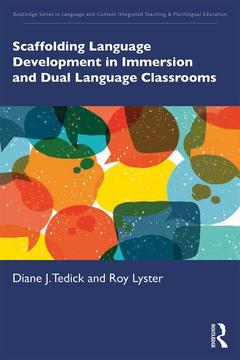Description
Scaffolding Language Development in Immersion and Dual Language Classrooms
Routledge Series in Language and Content Integrated Teaching & Plurilingual Education Series
Authors: Tedick Diane J., Lyster Roy
Language: English
Subjects for Scaffolding Language Development in Immersion and Dual...:
Keywords
Spanish L1 Student; Research and practice; Past Tenses; Plurilingual Education; L3 Learners; Teacher Education; Vice Versa; Language Scaffolding; ELA; non-english; TWI Program; Bilingual; Academic Language Functions; Dual language; Instructional Languages; Immersion teaching; Classroom Level Assessment; content-based language teaching; French Immersion Teachers; school-based immersion program; Performance Assessment; language development; TWI Classroom; dual language classroom; Minority Language Development; Dual Language Classrooms; Minority Language Students; Skill Acquisition Theory; Dual Language Education; Teacher Performance Assessment; Minority Language; Majority Language Students; IRI Program; French Immersion Programs; English Language Development; Ire Sequence; Oral CF
Publication date: 12-2019
· 15.6x23.4 cm · Paperback
Publication date: 12-2019
· 15.6x23.4 cm · Hardback
Description
/li>Contents
/li>Readership
/li>Biography
/li>
This book introduces research-based pedagogical practices for supporting and enhancing language development and use in school-based immersion and dual language programs in which a second, foreign, heritage, or indigenous language is used as the medium of subject-matter instruction. Using counterbalanced instruction as the volume?s pedagogical framework, the authors map out the specific pedagogical skill set and knowledge base that teachers in immersion and dual language classrooms need so their students can engage with content taught through an additional language while continuing to improve their proficiency in that language. To illustrate key concepts and effective practices, the authors draw on classroom-based research and include teacher-created examples of classroom application. The following topics are covered in detail:
- defining characteristics of immersion and dual language programs and features of well-implemented programs
- strategies to promote language and content integration in curricular planning as well as classroom instruction and performance assessment
- an instructional model to counterbalance form-focused and content-based instruction
- scaffolding strategies that support students? comprehension and production while ensuring continued language development
- an approach to creating cross-linguistic connections through biliteracy instruction
- a self-assessment tool for teachers to reflect on their pedagogical growth
Also applicable to content and language integrated learning and other forms of content-based language teaching, this comprehensive volume includes graphics to facilitate navigation and provides Resources for Readers and Application Activities at the end of each chapter.
The book will be a key resource for preservice and in-service teachers, administrators, and teacher educators.
INTRODUCTION
PART I: WHAT IS IMMERSION AND DUAL LANGUAGE EDUCATION?
Chapter 1: From Goals and Outcomes to Program Models and Characteristics
Chapter 2: Characteristics of Well-Implemented Immersion and Dual Language Programs
PART II: WHAT IS COUNTERBALANCED INSTRUCTION?
Chapter 3: Counterbalanced Instruction: Its Rationale and Key Characteristics
Chapter 4: Contextualization, Awareness, Practice, and Autonomy: The CAPA Model
PART III: WHAT IS SCAFFOLDING?
Chapter 5: Effective Scaffolding and Questioning Techniques
Chapter 6: Corrective Feedback
PART IV: CURRICULUM PLANNING AND ASSESSMENT
Chapter 7: Unit-Level Instructional Design
Chapter 8: Module and Lesson Design
Chapter 9: Scaffolding Biliteracy Development
Chapter 10: Performance Assessment
CONCLUSION
REFERENCES
Appendix A: ImDL Unit Design Example
Appendix B: ImDL Module and Lesson Design Example
Appendix C: ImDL IPA Example
Appendix D: Self-Assessment Rubric for ImDL Teachers
Appendix E: Answer Keys
Index
Diane J. Tedick is Professor of Second Language Education at the University of Minnesota. Her research interests include student language development in immersion classrooms, content-based language instruction, and immersion/dual language teacher education and professional development. She provides professional development experiences for immersion and bilingual teachers in the U.S. and internationally. She has co-edited two books on immersion, both published by Multilingual Matters: Pathways to Multilingualism: Evolving Perspectives on Immersion Education (2008) and Immersion Education: Practices, Policies, Possibilities (2011). She has twice received the U.S. Paul Pimsleur Award for Research in Foreign Language Education, in 2013 with co-recipient Laurent Cammarata, and in 2016 with Tara Fortune.
Roy Lyster is Professor Emeritus of Second Language Education at McGill University. His research examines content-based second-language instruction and the effects of instructional interventions designed to counterbalance form-focused and content-based approaches. He was co-recipient with colleague Leila Ranta of the 1998 Paul Pimsleur Award for Research in Foreign Language Education and was presented the Robert Roy Award by the Canadian Association of Second Language Teachers in 2017. He is author of a module called Content-Based Language Teaching published by Routledge in 2018, and two books: Learning and Teaching Languages Through Content published by Benjamins in 2007 and Vers une approche intégrée en immersion published by Les Éditions CEC in 2016.




